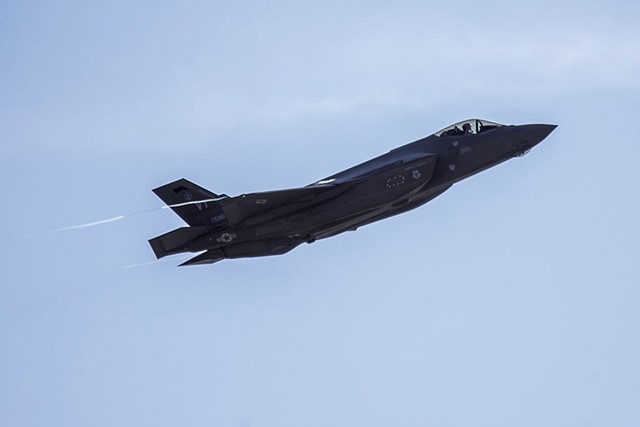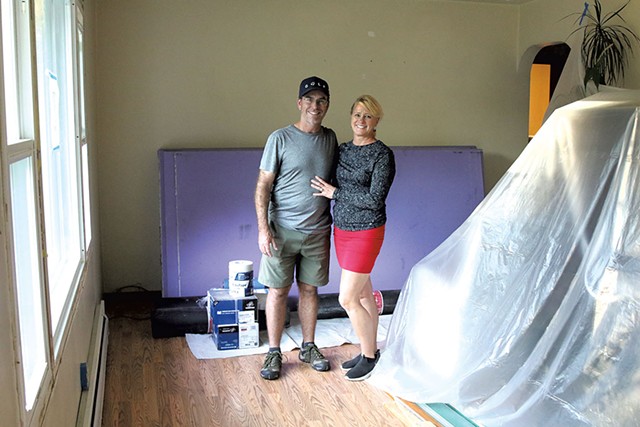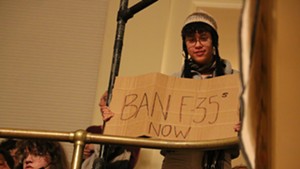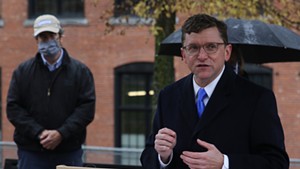
- File: James Buck
- F-35
Jennifer Bouffard has lived on South Henry Court, a quaint South Burlington cul-de-sac near the airport, her entire life. She met her future husband, Joe, in the neighborhood when they were just teenagers in the 1980s. When they got married, they bought a house across the street from her childhood home.
The couple love where they live. So when the Burlington International Airport offered to buy their home several years ago to reduce their exposure to jet noise, the Bouffards said no — then watched as their neighbors' homes were purchased and demolished. They stayed even after learning that a louder jet, the F-35, was destined to replace the Vermont Air National Guard's F-16s that flew out of BTV.
Four years after the F-35s arrived, an airport program is finally paying to insulate a handful of nearby homes from the roar of the jets' engines. The Bouffards are among the lucky ones. Their home was first on the list, and last week airport contractors began installing new windows, doors and drywall to dampen the sound. Theirs and 14 others will be finished this year, airport officials say.
But there are hundreds more to go, and the program is already behind schedule. Inflation has doubled the cost of materials, meaning half as many homes will be renovated each year than originally planned. All told, it could take decades before work is complete on every eligible home.
Aviation Director Nic Longo plans to seek more federal funding that could speed up the process but said the delays are otherwise out of the airport's control. "I think the best word is 'frustrating,'" he said.
The airport bases its program on a noise exposure map, a computer-generated depiction of where the jets are loudest. The most recent version was released in 2019, before the F-35s even arrived in Burlington. It shows 2,640 homes in three "contours" — 65, 70 and 75 decibels or higher. Most are in Winooski and South Burlington, but homes in parts of Burlington, Williston and Colchester are also affected.
Not every home in those three zones will qualify for the work, however, including those built after 1999 and others that meet federal standards based on indoor acoustic testing.
Eleven homes that are closest to the airport, in the 75-decibel contour, are also disqualified. The Federal Aviation Administration says properties in that noise zone shouldn't be used as housing and won't pay to insulate them. The residents can stay put or sell their houses to the airport for fair market value. The airport would raze the homes, just as it did to 200 others during a previous iteration of a sound-abatement program that started in the 1980s.
Dumont Avenue resident Edward Garvey owns one of those houses and said he just isn't selling. The retired airline employee has lived in his modest ranch for 65 years. He's frustrated that his home isn't eligible.
"They gave up on us," he said.
The airport is starting work in the 70-decibel zone, where 283 homes were deemed eligible for the program. The 2,344 homes in the 65-decibel zone are being tested now, a process that Longo said could take a year.
The airport currently has $15 million in FAA grants to start the insulation work. Longo estimates that the airport will need $5.5 million from the FAA every year to finish the project, but that money isn't guaranteed.
And the project will take longer than anticipated. In early 2020, the airport planned to renovate 100 homes a year for about $50,000 a pop. When the pandemic hit, inflation spiked, driving up the price of windows, doors and other materials — and doubling the expected cost per home. Suddenly, the FAA grant will only go half as far, and the airport revised its goal to 50 homes per year. Then a window manufacturer went bankrupt, causing more delays while the airport searched for another one.
If all goes as planned, it will take six years to insulate the homes in the 70-decibel zone — and potentially 40 more years for those in the 65-decibel zone, if they all qualify.
Further complicating matters, the airport plans to release a new noise map next spring, rendering the current one obsolete. Homes within the contours now may not be next year and vice versa, Longo said, though he thinks it's likely that more homes will be added to the map than removed from it.
Winooski resident Marguerite Adelman's condo isn't in the noise abatement zone, but she thinks it should be. Adelman, who is hard of hearing, said the jet noise is intolerable in both her backyard and her home with the windows open. But even if her condo were added to the new map — and determined eligible — it would likely be on the outermost contour, meaning it could be one of the last ones to be insulated. Adelman, who is 70, worries that she and her husband won't be around to hear the difference.
"We will be dead," she said. "I mean, maybe I could live to 110, but somehow I doubt it."
The new map aside, Longo is slightly more optimistic about the program's pacing. He said the airport plans to apply for a new $18.7 million noise-mitigation grant program from the U.S. Department of Defense, which it would use to insulate more homes. Longo said he's confident that the airport will receive some of the cash because the F-35s are already here and the insulation work has started. The awards will be announced in the spring.
"We're ready for these funds right now," Longo said.
Some residents think the only solution would be to get rid of the jets altogether — an unlikely prospect but one that was raised several times at a community meeting at Chamberlin School in South Burlington last month. The school, which is about a mile from the airport, was outfitted with central air conditioning two years ago as part of the noise reduction program. Winooski public schools are just outside the noise contours and aren't eligible for any renovations.
South Burlington resident Colin Graybuck was among those calling for the jets' removal. His wife, Claire, bought their home on Peterson Terrace in 2017, when the F-16s were still based in Burlington. She recalled sitting in her car to get a sense of the jet noise before putting an offer on the house. It was tolerable.
But then came the F-35s. The jets are so loud, Colin said, that he's heard them fly over when he's wearing noise-canceling headphones while working with power tools in his garage.
The couple's home is eligible for sound insulation. Besides the typical upgrades, their home will also get central air conditioning so they can keep the windows shut year-round.
But the Graybucks, who enjoy letting in the fresh spring air, aren't satisfied. The program might make their home quieter, but it doesn't address any noise outside.
"It's something," Claire said, "but it's a Band-Aid on a bullet wound." Her husband agreed. He's happy to qualify for the program, "but I'm not happy to need it," he said.

- Courtney Lamdin ©️ Seven Days
- Joe and Jennifer Bouffard
Last week, half a mile away on South Henry Court, work at the Bouffards' home was well under way. In two days, the contractors had replaced a large bay window and nine smaller ones. Electricians were preparing to install mini-splits for heating and cooling.
"It's been managed very well," Jennifer Bouffard said. "The downfall to the whole project is the inconvenience of it."
And it has been disruptive. The Bouffards had to move loads of furniture and other belongings into their garage; what was left inside is covered in a thin, plastic sheet. Evicted from their bedroom, the couple have had to sleep on an air mattress in the basement for three weeks. Their old cat, Willis, has found respite in the bathroom.
The Bouffards have made it work, but they worry that older residents will find the program too burdensome to participate. The airport doesn't pay for movers, storage or alternative lodging.
The couple have also lived next to the airport long enough to be skeptical of its future plans. After demolishing so many homes, BTV owns a sizable chunk of land around the Bouffards' home. They wonder whether the airport, should it want to expand, would someday try to take their property.
For now, though, they're pleased with the work. One morning last week, Jennifer was on a video call when she heard a plane take off. When another one flew over seconds later, she realized it was an F-35, because they often take off in batches.
Once disruptive, the jets already sounded much quieter.
Editor's note: Joe Bouffard is a longtime Seven Days circulation employee.










Comments
Comments are closed.
From 2014-2020, Seven Days allowed readers to comment on all stories posted on our website. While we've appreciated the suggestions and insights, right now Seven Days is prioritizing our core mission — producing high-quality, responsible local journalism — over moderating online debates between readers.
To criticize, correct or praise our reporting, please send us a letter to the editor or send us a tip. We’ll check it out and report the results.
Online comments may return when we have better tech tools for managing them. Thanks for reading.